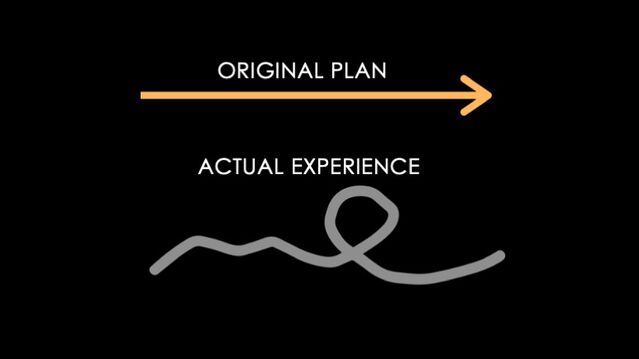Creativity
Three Ways to Cultivate Serendipity
Expect the unexpected and recognize what has been holding you back.
Posted June 9, 2022 Reviewed by Lybi Ma
Key points
- Many of the world's leaders have developed an often-unconscious ability to turn the unexpected into positive outcomes.
- Serendipity, smart luck, is about seeing bridges where others see gaps, then taking initiative and action.
- There are three self-limiting constraints that can keep us from experiencing more smart luck.
- When we overcome these constraints, the unexpected can transform from a threat to an ally—becoming a source of possibility.
"The way you deal with the unexpected defines who you are."—Hubert Joly, former CEO of BestBuy
There is comfort in certainty. Knowing where the journey is going, and having a plan, provides reassurance in a fast-changing world. But there is another force, constantly at play in life, that often makes the greatest difference to our futures: the “unexpected” or the “unforeseen.” And how we deal with the unexpected truly defines who we are.
In my research on what makes individuals and organizations prepared for the future, one finding keeps coming up: Many of the world's leaders have developed an often-unconscious ability to turn the unexpected into positive outcomes. Developing this "serendipity mindset" is a skill you can shape and nurture yourself.
You probably already pay attention to the unexpected every day, but often only as a defense mechanism. For example, if you're using a crosswalk on a busy street, you watch out for a driver who might speed through the red light. This "alertness" to the unexpected is at the heart of understanding the science of “smart luck,” of serendipity.
Do you hold yourself back from having more serendipity in your life?
Serendipity is a driving force in great scientific discoveries, but it is also present in our everyday lives. We often unexpectedly find love, co-founders, a new job, a new idea, or business partners. You might think of serendipity as passive luck that just happens to you (or others), when, in fact, it is an active process of recognizing and connecting dots. Smart luck is about seeing bridges where others see gaps, then taking initiative and action.
I have described some day-to-day strategies that can help us cultivate serendipity in our lives. But there are self-limiting constraints that keep us from experiencing more “smart luck.” Some of this is about removing physical or social obstacles, such as overloaded schedules, meaningless meetings, and inefficient daily routines that rob us of time, curiosity, and a sense of joy. But most importantly, it's about removing mental barriers. An unprepared mind often dismisses unusual encounters and misses opportunities for serendipity.
There are three key self-limiting constraints that can keep us from experiencing more “smart luck.”
1) Are you underestimating the likelihood of the (positively) unexpected?
It's natural to underestimate the unexpected, but when you do, you block out opportunities to create serendipity. It's unlikely that Zoom will crash on the day of your big presentation. It's unlikely that the person who was supposed to evaluate your presentation will get sick. It's unlikely that you'll spill coffee all over your laptop right before your presentation. But when you add up all of these unlikely events, it becomes relatively likely that something unexpected will happen. Experienced presenters often have a joke ready when something goes wrong, because they know it often does, and that's how they get the audience on their side.
The same logic applies to all the good things that can happen during the day. Only when we accept that the unexpected happens all the time do we start to see it. Take as an example a British study that involved two people: One who considered themselves "lucky" and one who considered themselves "unlucky." The researchers asked both participants to go separately to a café in front of which they had placed money (a five-pound bill) on the sidewalk. Inside, a successful businessman sat at a table next to the counter. When the "lucky" person approached the money, they spotted it and took it. Inside, they ordered a coffee, sat down next to the businessman, and began a conversation with him.
The "unlucky person," on the other hand, neither noticed the money nor started a conversation with the businessman. Later, the researchers asked both participants how their day had gone. The "lucky person" reported that they had a great day: they had found money on the street and made a new friend (who could open up more opportunities for them). The "unlucky person," on the other hand, described the day as uneventful. Thus, although both participants had the same (unexpected) opportunities, only one was able to seize them.1
2) Are you airbrushing coincidences out of your life?
When we construct stories about past events, we often pretend that there was a linear progression, when in fact reality most likely followed a convoluted path.
This can lead us to perceive events as more predictable than they actually were ("hindsight bias"). We construct narratives that conveniently explain everything and ignore the role of chance. This so-called “post-rationalization” corresponds to our human desire to find familiarity in the unknown and to control anomalies. However, if you block out the many unexpected events from your narratives, you fail to recognize the importance of the unpredictable and therefore fail to recognize the crucial role that chance can play in your future. Try asking yourself and others what surprised you this past week. You never know what can come out of those moments—and how they will make you look differently in the future.

3) Are you functionally fixed?
When we use a tool in everyday life, we are usually so accustomed to its specific function that we are often unable to see its usefulness in other contexts, or that other tools might be more effective (functional fixedness). When you need a nail in the wall you might search for a hammer rather than looking for any heavy object that might help you get the nail into the wall.
Similarly, research has shown that people who are familiar with certain problem-solving strategies rarely develop simpler strategies, even when it would be useful to do so.2 In other words, we often take the "hard way" simply because we know it. But an essential prerequisite for "smart luck" is the mental agility to show imagination and see how a tool can be used in a new way.
Think of characters like Lara Croft or James Bond, who can turn any ordinary object into a deadly weapon. It's a Hollywood cliché, but we're still impressed by these characters because we recognize their talent and ingenuity, and perhaps how unlikely it is that we would have come up with the same solution in their situation. Your own creativity will thrive when you challenge the physical and mental tools you are most familiar with and allow yourself to think and work in new and different ways.
When we overcome these three self-limiting constraints, the unexpected can transform from a threat to an ally—and become a source of possibility, joy, and meaning. We start engineering serendipity.
References
[1] Busch, C. 2020. The Serendipity Mindset: The Art and Science of Creating Good Luck. New York: Penguin Random House; Wiseman, 2003. The Luck Factor. New York: Arrow.
[2] Von Hippel, E., & von Krogh, G. 2016. Identifying Viable “Need–Solution Pairs”: Problem Solving Without Problem Formulation. Organization Science, 27(1): 207-221.




